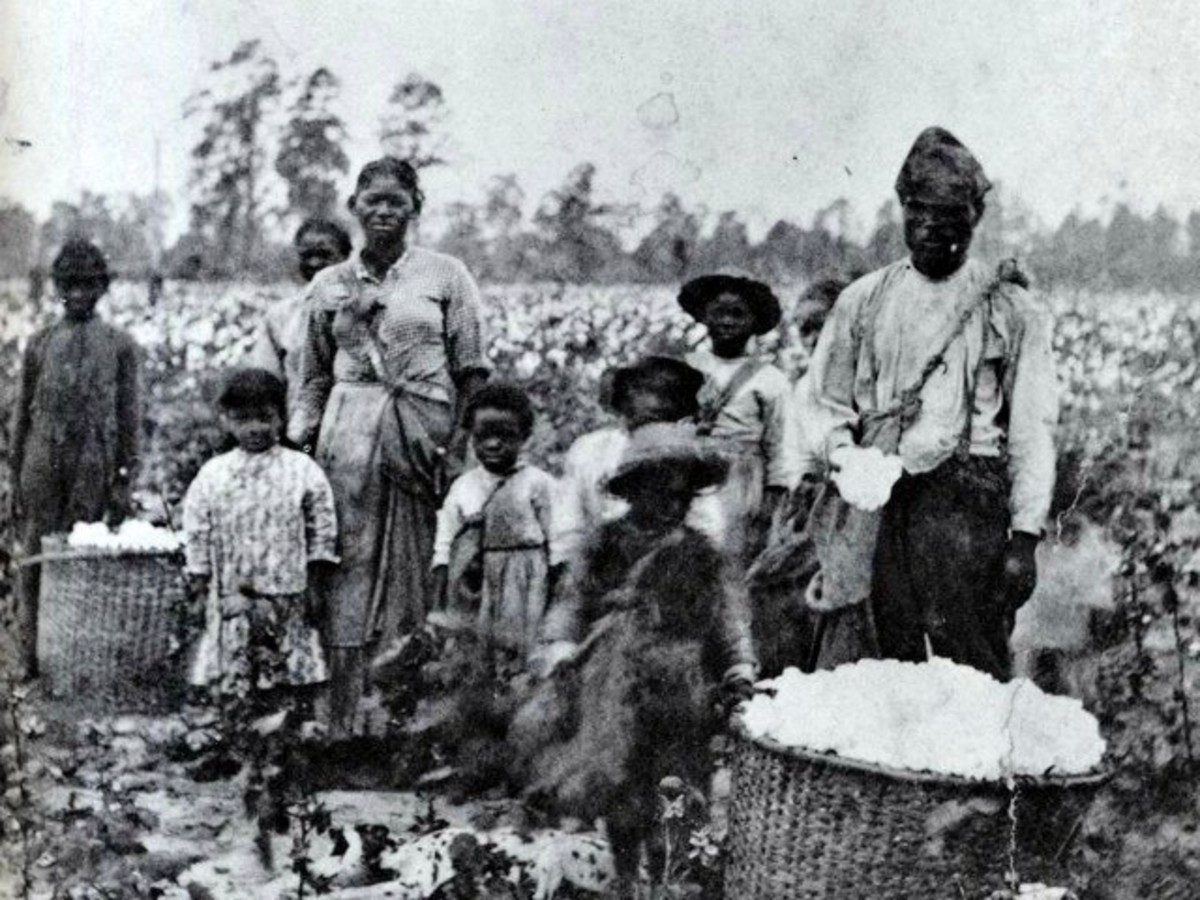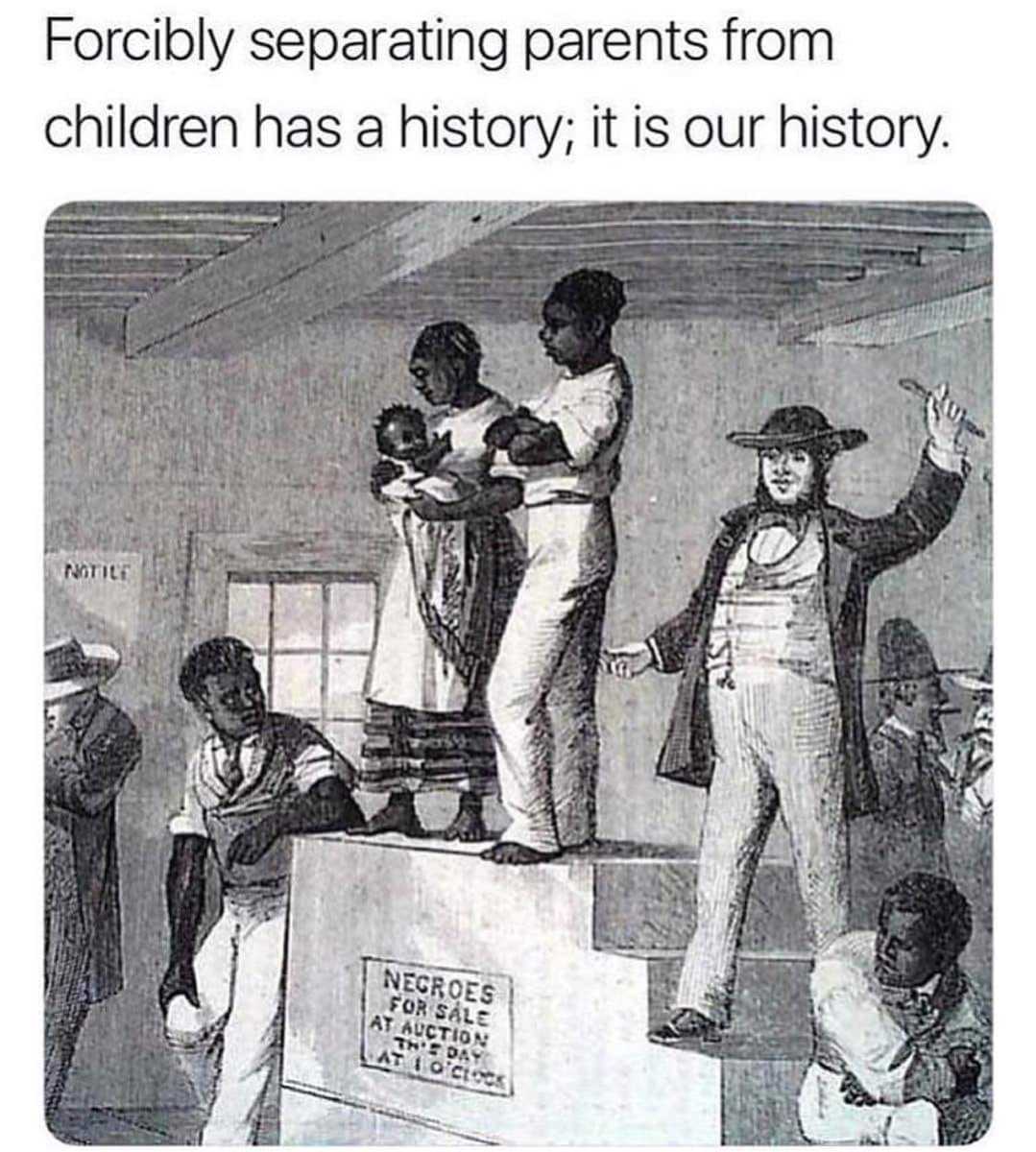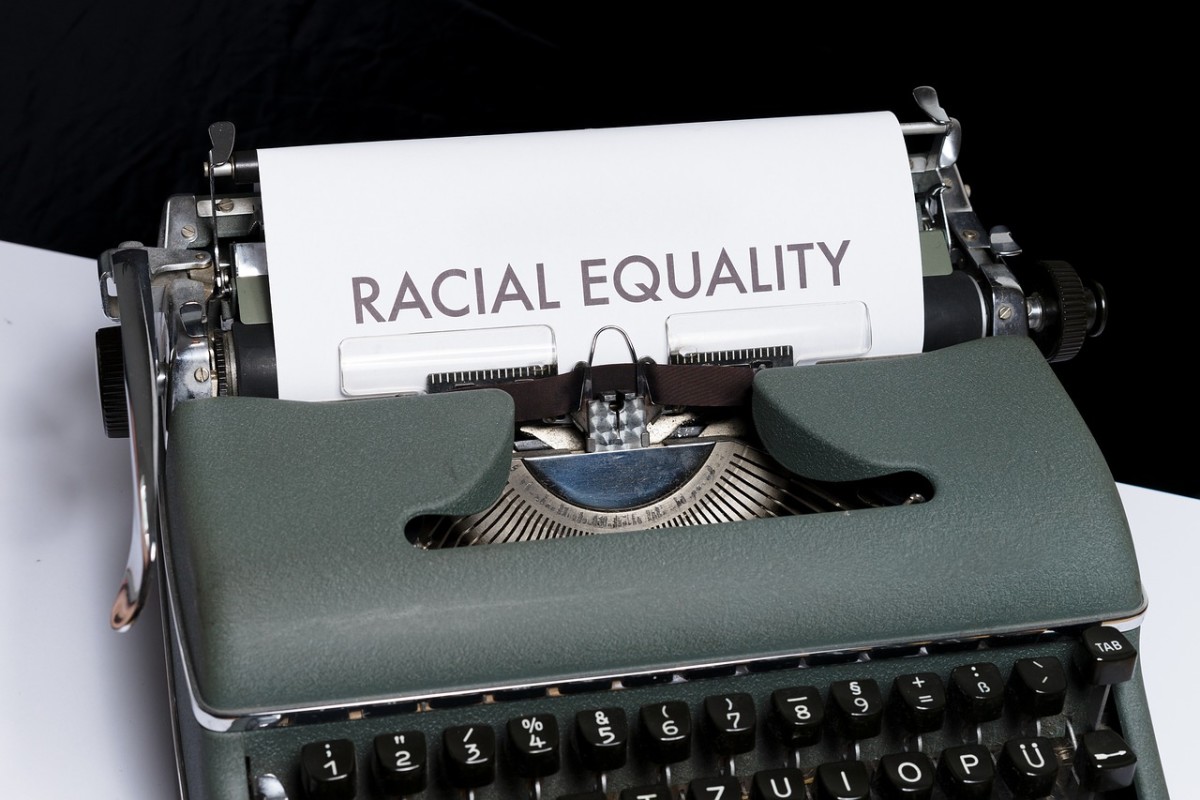Unemployment and Race In 2012 It Still Matters
Figure 1 and 2
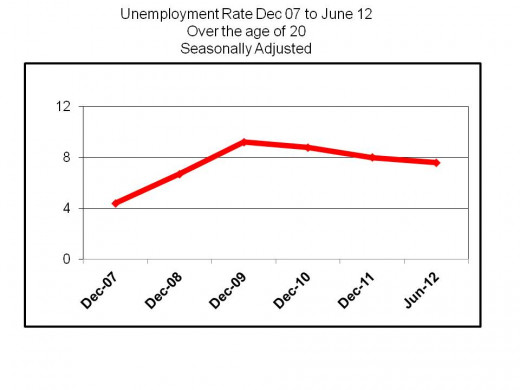
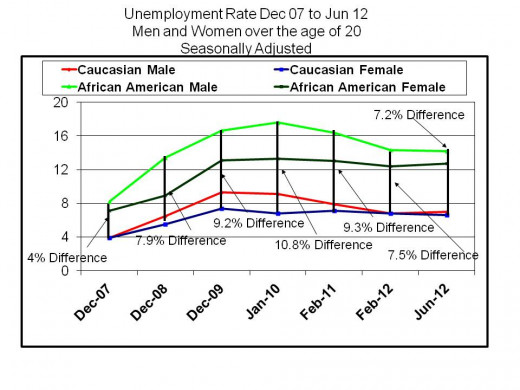
Unemployment and Race: In 2012 It Still Matters©
To be a poor man is hard, but to be a poor race
in a land of dollars is the very bottom of hardships.[1]
W.E.B. Du Bois
Introduction
When I first addressed this issue in February 2010 the country was in the midst of a recession and the conclusion that the article came to was economic hardship hit specific demographic groups harder than others. As the economy starts to improve and job availability continues to rise, it is time the prosperity applies to all. So that we are able to move beyond W.E.B. Du Bois quote.
There should little debate that throughout 2010 this country was in the grips of a recession and according to one report, in 2012 we are still in the recession, “Wealthier Americans aren't very optimistic about the economic recovery, with a surprising 63 percent saying the US is still in a recession, according to a new poll.”[2] As such, any report by the government that will potentially affect the checkbook of individuals becomes newsworthy. However, the news rarely presents a complete story.
The following is the opening line from a February 5, 2010, Associated Press (AP) article offering a little bit of hope for the economy. “The outlook for jobs became a bit less bleak with January's unexpected decline in the unemployment rate, which fell to 9.7% from 10%.[3]” (Figure 1[4]) While the drop in unemployment is a positive, the article goes on to say, “But those gains resulted from seasonal adjustments to the data. Without those adjustments, the data show fewer people had jobs last month.[5]” At the end of July 2010, the seasonally adjusted rate was 8.8%, and in July 2012 it has settled in at 8.0%[6]. There is a little confusion whether or not there is any improvement in the economy, based on how the numbers are counted. One set, seasonally adjusted shows an improvement, while the non-adjusted figure shows less job growth. In addition, who is counted as unemployed, affects the overall presentation of the data. Just because a person is an adult and out of work does not mean that they are automatically counted. The Department of Labor (DOL) has specific definition, “People are classified as unemployed if they meet all of the following criteria: they had no employment during the reference week; they were available for work at that time; and they made specific efforts to find employment sometime during the 4-week period ending with the reference week. Persons laid off from a job and expecting recall need not be looking for work to be counted as unemployed.[7]” Left out of the over all statistics are people who are institutionalized and people unable or unwilling to look for work.
Even with all the confusing data, it is safe to say the unemployment situation, even with the reported improvement, is still a problem. On average, the unemployment rate was steadily increasing from December 2007 to December 2009, and then it started to decrease starting in January 2010, until it reached its current rate. When the government announces the rate for the whole country, it appears as if we are all feeling the same level of pain and relief of these economic times. The announcement of the reduced unemployment rate is presented as if the drop is the same for everyone. But, has the impact of the recession and the start of a recovery been truly felt equally for all Americans?
Figure 2[8] shows the comparative unemployment rate[9] between Caucasians[10] and African Americans[11] since December 2007. It should be noted at the beginning of this period the difference between Caucasian females (lowest unemployment rate at 4%) and African American males (highest unemployment rate at 8%) was only 4%. With the numbers release by the Department of Labor on February 4, 2010, that gap reached its peak at 10.8% by February of 2012 the gap was reduced by 7.5%. The unemployment rate, on average, decreased between December 2009 and February 2012, for the nation as a whole, which is a good thing, however until January 2010 the unemployment rate continued to increased for African American males and females. Between January 2010 and the present the rate for African American males and females began to drop, but at a slower rate. A conclusion that can draw from these numbers is that the recession, the lack of employment, and a significantly slower recovery has hit the African Americans community harder.
If the claim is that African American males are significantly impacted as compared to their Caucasian counter-parts, then the next step is to see how they compare against other groups. For example, Hispanics[12] from December 2008 to July 2010 the unemployment rate rose from 9.9% to 12.1%, with a peak at 13.1% in October 2009. But even at 12.1%, they were 4.6% below that of Black males. As of June 2012 the seasonally adjusted unemployment rate for Hispanics was at 11.0% while it was at 14.4% for African Americans. Again, these numbers do not say anything except that African Americans are significantly impacted by the current employment situation. The numbers may indicate there is a disparity, but they do not show why it exists.
Figure 3 and 4
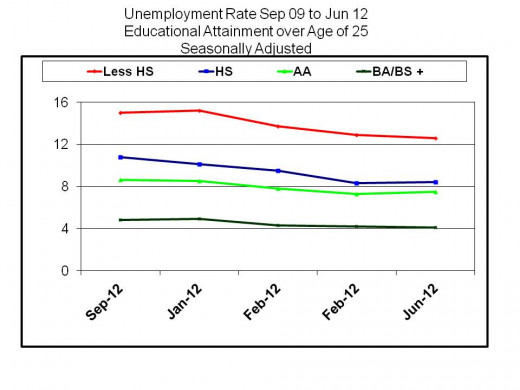
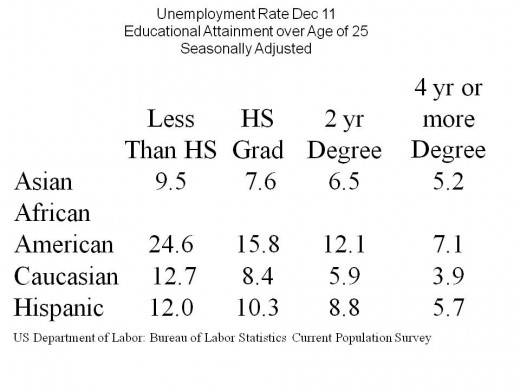
Education
One possible source for an answer is to review the educational attainment statistics in relation to the unemployment rate. Figure 3[13] shows that on average there is a positive correlation between educational attainment and employment. The higher a person’s educational level is, the lower the unemployment rate is. This intuitively makes sense; the reason that many people continue with the educational process is to improve their marketability. The June 2012 numbers show that the unemployment rate for a person without a high school education is 8.5%[14] higher than a person with a four-year degree or higher. If we break this statistic further down by race, we find another phenomenon is revealed. The information in Figure 3 would suggest that educational attainment is an important factor in gaining and retaining employment. However, the information provided in Figure 4[15] would suggest something else is in play in the job market. According to the data, the unemployment rate for African Americans with a two (2) year degree is higher than it is for Caucasians with just a High School Diploma. The same disparity holds true for African Americans with a four (4) year or higher degree. Their unemployment rate is higher than it is for Caucasians with just a two (2) year degree. Suggesting that race does play a significant factor in employment opportunities in this country.
Other Groups
While the employment statistics for African Americans are higher, there is another group that is in worse shape. For the employment statistics that were just presented, the information for Caucasians, African Americans, Asians[16] and Hispanics is easily accessible. A review of the data presented on the DOL’s web site will reveal that only three races and one ethnicity are routinely reported. What is hard to find is any information on the indigenous population of America. Admittedly, the Bureau of Labor Statistics (BLS), in an effort to comply with the 2000 Census data does not routinely report data on some racial groups. “To accommodate the new guidelines, the race categories that now appear in Bureau of Labor Statistics (BLS) publications are white (and no other race), black or African American (and no other race), and Asian (and no other race). The number of respondents in the remaining categories—American Indian or Alaska Native, Native Hawaiian or Other Pacific Islanders, and persons who selected more than one race category—was determined to be too small to develop employment and unemployment estimates of sufficient reliability for monthly publication.[17]”[18] [19] Going to the BLS web sites it is a challenge to find any relevant employment information on these groups.
The next couple of paragraphs are going to focus on the data that is available for American Indians because the employment picture appears to be bleaker. The primary source of employment information for this group is supposed to be the Department of the Interior, Bureau of Indian Affairs (BIA). While the BIA has a fixed reporting requirement governed by “Public Law 102-477, the Indian Employment, Training, and Related Services Demonstration Act of 1992, mandates that the Bureau of Indian Affairs (BIA) publish, not less than biennially, a report on the American Indian and Alaska Native population who are eligible services provided by the Secretary of the Interior to American Indian and Alaska Native People.[20]” But even with this requirement, the last published report was release in 2005. On July 2, 2012, Donald E. Laverdure the Acting Assistant Secretary – Indian Affairs wrote to the tribal leaders to inform them that, “ the Department of the Interior will not release the 2010 Indian Population and Labor Force Report because of methodology inconsistencies. We believe this to be the best decision given the circumstances involved, and a determination that will best serve the long-term interests of American Indians and Alaska Natives.[21]” Therefore, the data available from the BIA for review is seven years old.
Counting American Indian unemployment becomes difficult based on a number of factors. Estimates at the start of 2009, based on report published by data Economic Policy Institute (EPI), have the rate at 13.9%[22] while the BIA reported in 2005 the unemployment rate at 49%. The EPI report is basing its information on the data it was able to uncover from the BLS. In a Democratic Policy Committee press release on February 19, 2009, Senator Byron Dorgan (D-ND), chairman of the Senate Committee on Indian Affairs[23] (SCIA), stated that the average unemployment rate for Tribal communities is roughly 50%. In a White House press release, part of the justification for a jobs program for Native Americans, “With as many as 80 percent of Native Americans out of work on some reservations.[24]” It is easy to see that the number differs greatly about Native American unemployment. This is due in part to the methodology used by the agencies. No matter the method or source of information, it is clear to see that the Native American population unemployment rate outpaces other segments of the population.
Figure 5
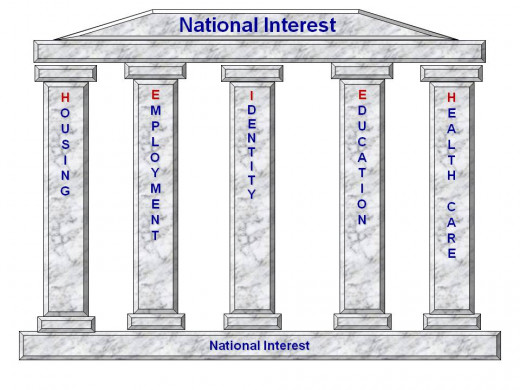
What to do with the information?
Regardless of the data source, the data consistently shows that the recession has hit three demographic groups harder than the rest of the country. The report published by EPI, describes the disparity, “American Indians,like Hispanic Americans and African Americans, have had the misfortune of experiencing double-digit unemployment rates for most or all of 2009. In the first half of this year, the American Indian unemployment rate averaged 13.6%. This rate is up from 7.8% in the last half of 2007, and it is 5.4 percentage points higher than the comparable 2009 Caucasianrate. All groups are being hurt by the Great Recession, but the pain is more severe in communities of color.[25]” The author is clearly stating what many people have suspected or known, race still plays a major role in employment decisions in this country. Roughly, 150 years after the Civil War, and 130 years after the Indian Wars, skin color is a contributing factor in determining a person’s economic worth.
How people approach the information that has been presented will depend greatly on their current economic status. If the reader of this article is a Caucasian male, that happens to be in the 7% that is unemployed, they may be aware that unemployment affects other racial groups more, but that will not be their first concern. Usually the first concern will be finding work to sustain themselves and their family. But as a nation, we have a responsibility and a vested interest in reducing the unemployment rate for all people of this country. To barrow a phrase from Jean-Jacques Rousseau there is a social contract that exists between the citizens and the government. Loosely translated the contract requires/mandates mutual support of the citizens. Rousseau describes the purpose of the contract was to, "Find a form of association which defends and protects with all common forces the person and goods of each associate, and by means of which each one, while uniting himself with all, may still obey himself alone, and remain as free as before.[26]" The only way to achieve this balance and cooperation is if the society provides for the security for all its citizens. Security, in the context of this article, is economic security. Deny a significant segment of the citizenry access to gainful employment and there will be a decay of the society. This decay will be caused in part by the strain on public programs and the disillusionment of the citizens towards their society.
Senator Jesse Jackson Jr., when he was speaking to the issue of reparations for slavery, hit the nail on the head when it comes to economic stability of Americans. "We should provide a full employment economy with jobs for ALL Americans, create a health care system that provides comprehensive and universal health care for ALL Americans, create a mixed economy that provides affordable housing for ALL Americans, invest in a public school system that provides a quality and multicultural education for ALL Americans, not just something for African Americans.[27]" According Senator Jackson, providing viable employment opportunities for all will help resolve many race related issues in this country. But this can only be achieved if the effects of the recession are equally distributed. Make the 9.7% apply to all working demographic groups.
Over two hundred years ago, Adam Smith clearly outlined the importance of labor to the wealth of a nation. “The annual labour of every nation is the fund which originally supplies it with all the necessaries and conveniences of life which it annually consumes, and which consist always either in the immediate produce of that labour, or in what is purchased with that produce from other nations.[28]” Labor, the production of goods and services, is vital for the economic recovery for this country. It is through employment that good and services are produced, but the workers have the income to purchase the items created.
Talking about the recession the economist Robert Heilbroner wrote, “National flood of income was indubitably imposing in its bulk, but when one followed its course into the millions of terminal rivulets, it was apparent that the nation as a whole benefited very unevenly from its flow. Some 24,000 families at the apex of the social pyramid received a stream of income three times as large as 6 million families squashed at the bottom.[29]” According to Heilbroner, the wealth of this nation is squarely in the hands of a few individuals. He later explains how unemployment starts to influence the economy. “It was employment that was the hardest to bear. The jobless millions were like an embolism in the nation’s vital circulation; and while the indisputable existence argued more forcibly than any text that something was wrong with the system, the economist wrung their hands and racked their brains and called upon the spirit of Adam Smith, but could offer neither diagnosis nor remedy. Unemployment—this kind of unemployment—was simply not listed among the possible ills of the system; it was absurd, unreasonable, and therefore impossible.[30]” What is interesting is that he was not writing about the economic recession of 2010, he was writing about the recession of 1920’s. Almost 100 years separate these two economic events, yet the particulars surrounding it are the same. The poorest section of the population takes on the brunt of a down economy.
Putting as many people to work is essential to recovery because high unemployment rates are expense to a society to maintain. This is simply Economics 101 high unemployment causes:
- An increase use of unemployment benefits
- Increase use of social services
- Increase in the default rate of loans
- Increase in criminal rate
- Decrease in productivity
- Increase in health issues
- Decreased revenue from taxes
This list is by no means complete. Nevertheless, it does give an insight into the fiscal impact the recession has on people and industry. In this country we have a theological and mythological foundation of equality that this nation claims to be based on. The myth is “Liberty and Justice For All”. Justice is not just limited to the legal system, people are entitled to economic justice as well.
Figure 5
From an economic standpoint this also makes sense, as I just said unemployment is expensive. The country needs the economic buying power that these groups can bring to the table, if fully employed, is in the billions.
However, it takes more than just a job to create economic success; the citizens need to believe that the national interest supports them as well. Along with employment, there are four other pillars support a society. (Figure 5) These pillars include housing[31], education, healthcare, and the means to have a sense of identity and self worth. If any groups feels that they are not supported then it is hard for them to give support back. The statement by John F. Kennedy, “And so, my fellow Americans: ask not what your country can do for you—ask what you can do for your country.”[32] Is something that you can ask of a people who have been supported by their government, it is not something you can ask of a people that have not.
There are three points that the reader should pull form this article.
- Assumptions that are made from just on one data set are rarely complete.
- Race does play a role in employment opportunity.
- It is in the best interest of this country to keep its population employed.
Footnotes
[1] Du Bois, W.E.B. The Soul of Black Folk. Barnes & Noble Books. 2005. Originally published 1903. Page 12
[2] Melstein, Robert. Business Insider.The Richest People In America Think We're Still In A Recession. http://articles.businessinsider.com/2012-03-09/markets/31138734_1_private-equity-bain-capital-firms. March 9, 2012. (accessed March 27, 2012)
[3] Yahoo. Drop in jobless rate points to modest improvement. http://news.yahoo.com/s/ap/20100205/ap_on_bi_go_ec_fi/us_economy. Accessed February 6, 2010
[4] U.S. Department of Labor Bureau of Labor Statistics. http://www.bls.gov/cps (access July 6, 2012)
[5] IBID
[6] U.S. Department of Labor Bureau of Labor Statistics.http://www.bls.gov/cps. (accessed July 6, 2012)
[7] U.S. Department of Labor Bureau of Labor Statistics. Employment Situation Technical Notes. http://www.bls.gov (access July 6, 2012)
[8] U.S. Department of Labor Bureau of Labor Statistics. http://bls.gov/webapps/legacy/cpsatab2.htm. ( accessed July 6, 2012)
[9] The unemployment rate is a percentage of those in the labor force who are unemployed
[10] White or Caucasian is defined as a person having origins in any of the original peoples of Europe, the Middle East, or North Africa
[11] Black or African American is defined as a person having origins in any of the black racial groups of Africa.
[12] Hispanic is defined as a person of Cuban, Mexican, Puerto Rican, South or Central American, or other Spanish culture or origin regardless of race.
[13] U.S. Department of Labor Bureau of Labor Statistics. http://www.bls.gov/cps/earnings.htm. (accessed July 6, 2012)
[14] IBID
[15] U.S. Department of Labor Bureau of Labor Statistics. http://www.bls.gov/cps/cpsaat07.htm. (accessed July 6, 2012)
[16] Asian is defined as a person having origins in any of the original peoples of the Far East, Southeast Asia, or the Indian Subcontinent, including, for example, Cambodia, China, India, Japan, Korea, Malaysia, Pakistan, the Philippine Islands, Thailand, and Vietnam.
[17] Mary Bowler, Randy E. Ilg, Stephen Miller, Ed Robison, and Anne Polivka. Revisions to the Current Population Survey Effective in January 2003. http://www.bls.gov/cps/rvcps03.pdf. Accessed February 8, 2010
[18] Native American is defined as A person having origins in any of the original peoples of North and South America (including Central America), and who maintain tribal affiliation or community attachment.
[19] A Native Hawaiian or Other Pacific Islander is defined as a person having origins in any of the peoples of Hawaii, Guam, Samoa, or other Pacific Islands.
[20] U.S. Department of the Interior, Indian Affairs. 2005 American Indian Population and Labor Force Report. http://www.bia.gov/idc/groups/public/documents/text/idc-001719.pdf. Access February 9, 2010
[21] U.S. Department of the Interior, Indian Affairs. http://www.bia.gov/cs/groups/public/documents/text/idc-019173.pdf. (accessed July 6, 2012)
[22] Austin, Algernon.American Indians and the Great Recession: Economic Disparities Growing Larger. http://epi.3cdn.net/1aaad254862c0b29b6_2em6bnkyh.pdf Access February 8, 2010
[23] I am willing to bet that most people did not know that the BIA or the SCIA even existed.
[24] White House. PRESIDENT OBAMA’S JOBS AND GROWTH PLAN: THE IMPACT FOR NATIVE AMERICANS AND THE ECONOMY. http://www.whitehouse.gov/sites/default/files/nativeamerican_factsheet_jobs.pdf. (Accessed July 7, 2012)
[25] Austin, Algernon.American Indians and the Great Recession: Economic Disparities Growing Larger. http://epi.3cdn.net/1aaad254862c0b29b6_2em6bnkyh.pdf. December 9, 2009. (access February 8, 2010)
[26] Rousseau, Jean-Jacques. The Basic Political Writings. On The Social Contract. Book I Chapter VI. Translated Donald Cress. Hackett Publishing Company, Indianapolis/Cambridge 1987. Page 148
[27] Jackson, Jesse Jr. An Apology For Slavery? Contrition Carries Conditions.. June 17, 1997. http://www.jessejacksonjr.org/
[28] Smith, Adam. An Inquiry into the Nature and Causes of the Wealth of Nations. Penguin Books. 1986. 104
[29] Heilbroner, Robert. The Worldly Philosophers: The Lives, Times, and Ideas of the Great Economic Thinkers. Simon & Schuster. p 250
[30] IBID p 252
[31] Housing represents more than just the physical structure; it also includes food, utilities, clothing and necessities.
[32] John F. Kennedy Inaugural Address Friday, January 20, 1961
© 2012 Mark Monroe



